350 Search Results for aided language input
March 8, 2013
by Robin Parker -
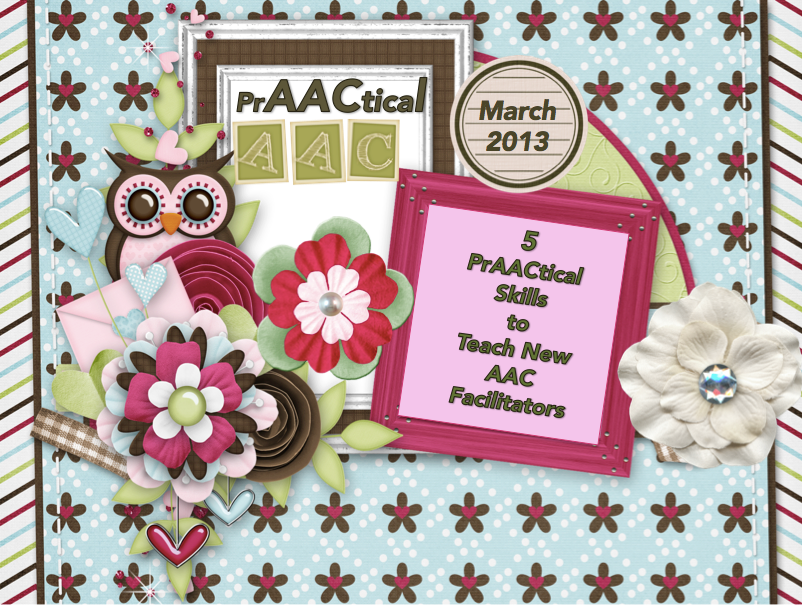
We have been out and about in our community these past couple of weeks. We have worked with speech-language pathologists, teachers, resource specialists, paraprofessionals, and families. We love doing AAC facilitator training because the impact is so important for not only our current AAC learners but for future AAC learners as well. There are really great professionals who want to provide the best AAC support possible. They want and need AAC information that will help them integrate AAC facilitation strategies into their already very busy days. Here are 5 AAC facilitation strategies that have made the most impact: Using Aided Language Input (ALI)– Talk AAC to the learner. This strategy is not only a very powerful teaching tool, but when discussed with new AAC facilitators, seems to make perfect sense (many have never heard of it). One key for learning ALI is to practice it in a variety of activities... [Read More...]
March 6, 2013
by Robin Parker -
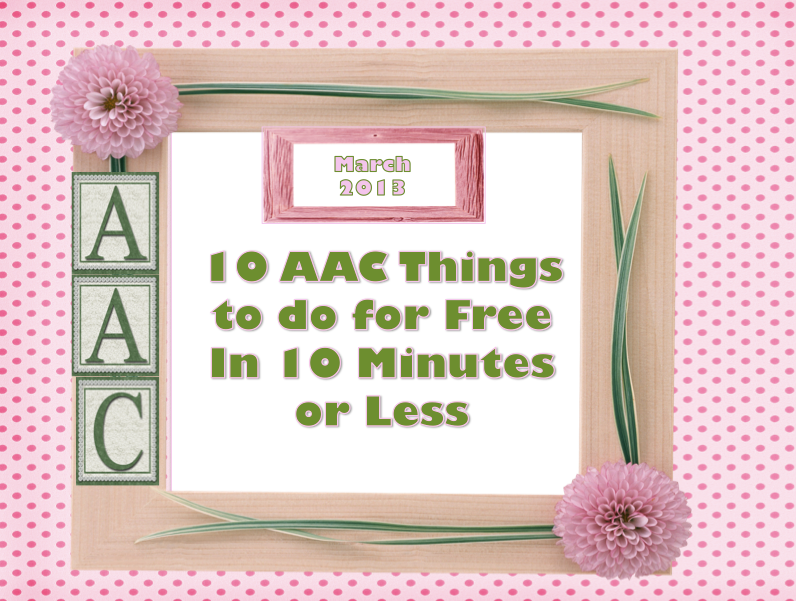
Subscribe to a blog with an AAC focus– Spectronics Blogs, Uncommon Sense, Jane Farrall Consulting, PrAACtical AAC Program a one hit message device and use it for a new reason– 101+ Things to do with a Big Mac or Other Single Message Communication Devices Follow an AAC topic Pinterest board– PrAACtical AAC, AAC by Katie Ahern, AT/AAC/Adapt/Modify/Accessibility/Accommodations, AT for Communication, AAC by Constantly Speaking, Communication-AAC Print out and hang up or give someone an AAC Awareness Image– 10 Commandments of AAC Devices, AAC It’s as Easy as 1,2,3 Register for a free AAC professional development webinar from Ablenet Print out an AAC Poster– AAC Boot Camp-Getting AAC Users to Communicate, The Periodic Table of AAC, Learn about technology and apps for AAC and learning from Pinterest– Lauren Enders Pinterest Boards, Tech in Special Education Print out song visual supports Read a Tar Heel Reader Book with an AAC learner... [Read More...]
March 4, 2013
by Robin Parker -

World Book Day is just 3 days away. Check out these PrAACtical ideas for celebrating. Just add AAC displays, aided language input, language facilitation strategies, and enthusiasm and World Book Day will be a special celebration. Dia Diversity in Action for 2013 Children’s Book Day- This blog post provides recommendations for a diverse Children’s Book Day (April 30th), but there are some great ideas that can be used for World Book Day. Exploring Children’s Literature through Book Trailers Great blog by K-5 teacher librarian who has been successful using book trailers as a way to connect readers with books. Think of how many learners would be excited and motivated by a video trailer about a book. Caught in the Act of Reading– a photo idea by Pragmatic Mom that we think would be a great classroom or therapy center activity for... [Read More...]
February 23, 2013
by Robin Parker -
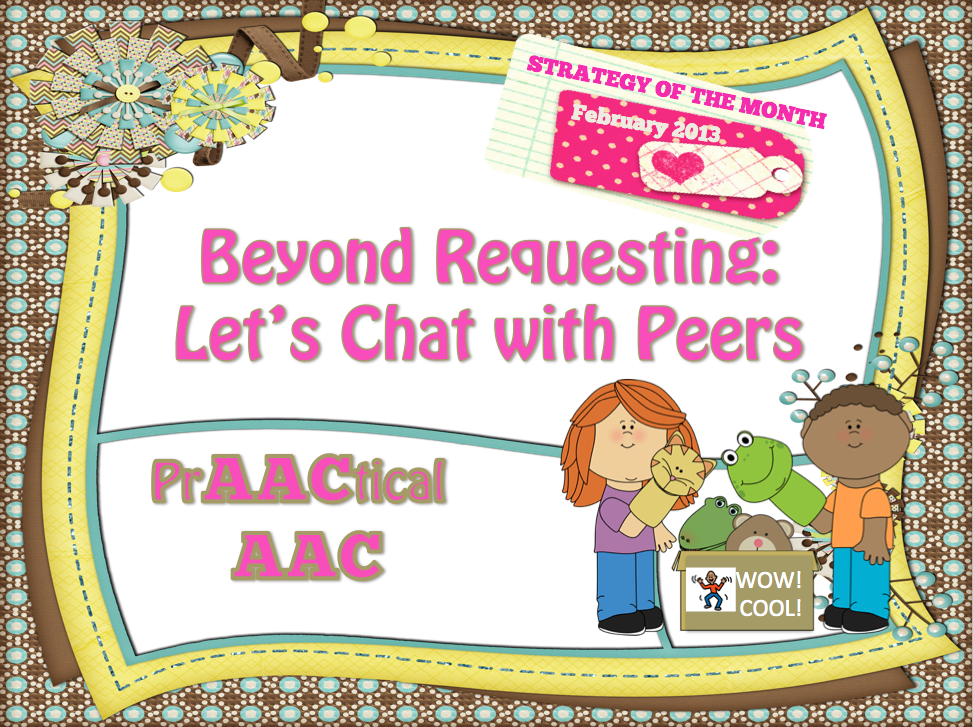
As we wrap up the February Strategy of the Month, we need to add strategies for helping AAC users talk/chat with peers. For some learners, it is more about providing access and opportunity while for others, it is more about providing a platform for the social awareness and exchange. However, for all learners who need assistance in ‘chatting’, there are many goals and strategies that will help. Setting the Foundation for Social Exchanges with Peers Provide frequent opportunities for peers to communicate with each other- Build in many opportunities within all (or almost all) activities for generic small talk, gossiping, & chatting. Create activities that have’ built in’ communication with peers- develop activities that require communication with peers to make the activity work. Instead of having all communication directed at the adults/facilitators in the room, have the learners talk to peers to take steps in the activity. Set up... [Read More...]
February 16, 2013
by Carole Zangari -

. A few weeks ago we talked about AAC intervention to teach someone how to convey information that others want or need. Giving instructions, answering comprehension questions, and retelling a story all fit into the Light’s category of ‘information transfer.’ Communicating in order to give information is only part of that story. Today, we complete the story by talking about getting information from others. Not all questions are about getting information, of course. We also ask questions for other reasons, like getting something we want or need (e.g., “May I have a drink, please?”) and socializing with friends/family (e.g., “How was your weekend?” “What did you do for your birthday?”). But in this post, we focus on interrogatives that serve the purpose of getting needed information from a communication partner. Many times when we think of interrogatives in language therapy, the focus is on answering them accurately and appropriately. The skill... [Read More...]
February 14, 2013
by Carole Zangari -
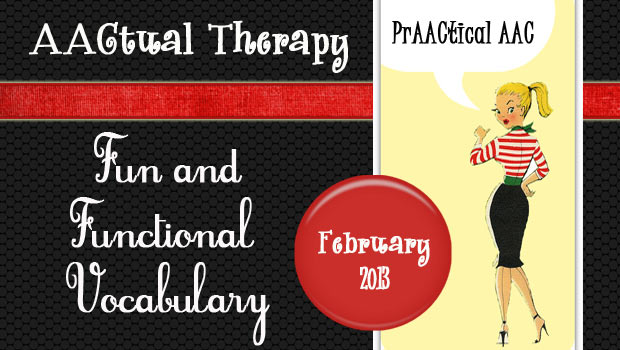
We are delighted to have Shareka Bentham back to share another post about the AACtual therapy she provides to little ones in Barbados. Last month, we followed her along to the zoo where her little friends got to generalize the language skills developed in therapy sessions. In this post, Shareka discusses her approach to something we all struggle with: selecting vocabulary that will both fun and functional. One of my biggest challenges in AAC is choosing good vocabulary targets, and working on vocabulary instruction for early communicators. By ‘good’ I mean targets which are functional for their everyday settings, representative, and most of all fun for children who are not only beginning communicators, but also beginning AAC users. I have become the AAC ‘specialist’ at a school for children with complex communication needs, so I generally have to cater to the communicative needs of children from the pre-communication to... [Read More...]
February 2, 2013
by Carole Zangari -
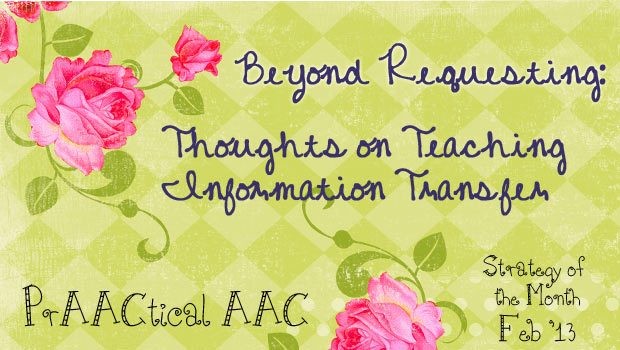
Although it has been close to 25 years since Dr. Janice Light’s hallmark paper on communicative competence in AAC discussed four main purposes of communication, many AAC systems are still heavily populated with messages for basic wants and needs. The other areas – information transfer, social closeness, social etiquette – are often underrepresented in AAC systems. We scratched the surface of how to teach basic requesting last month, and now we’re ready to talk about communicating for other reasons. In this post, we’ll talk about some of the clinical issues in teaching communication for the purpose of information transfer. A big reason that we express ourselves is to share information that others want or need. It may not seem like a high priority until we realize how often we need to do this to function in our daily lives. Here are some examples, both positive and negative, from our work... [Read More...]
January 31, 2013
by Carole Zangari -

We couldn’t be happier that one of our first AACtual Therapists is Tanna Neufeld, a south Floridian on loan to the Pacific Northwest. Tanna was with us as a graduate student many years ago, and went on to build a fantastic reputation in our community for her excellent clinical skills. It was South Florida’s loss when she left last year and moved across the continent. (I know at least a few people scheming of ways to get her back.) Tanna is now working at the Children’s Therapy Center in Seattle. Tanna blogs at SNEAK Outside the Box and My Blind Side. You can read more about her at the end of this post, in which Tanna talks about using bubbles in her AAC therapy sessions. AAC Breakthroughs with Bubbles! When I first started using core vocabulary boards with my kids, I didn’t really know where to start. It was really... [Read More...]
January 30, 2013
by Robin Parker -
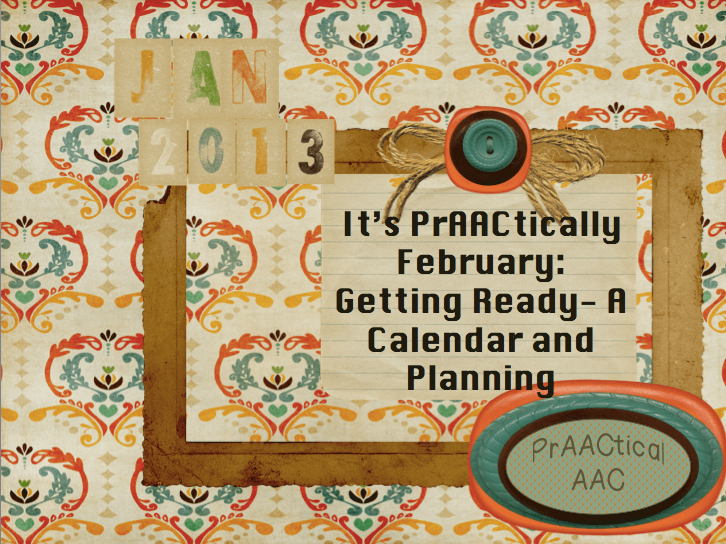
January is (was) a fairly crazy and busy month for us. After a late back to school week, the CARD Conference, the Dan Marino Foundation WalkAbout Autism, and ATIA Conference (hope to see you there), we got a bit of a late start on a few things. To stay ahead of ourselves, we want to end January by being ready for February…… For February, we have a calendar for incorporating AAC into everyday activities (it goes with yesterday’s post 28 things to do). Feel free to print out and share and use anyway you want to promote PrAACtical AAC. A PDF version (free) can be found at our Teachers Pay Teachers site. Our new Strategy of the Month (on Saturday) will focus on Communication & Language Beyond Requesting. There are no pre-requisites to learning and being immersed in ALL of the reasons to communicate (communication functions). For some learners, it... [Read More...]
January 29, 2013
by Robin Parker -
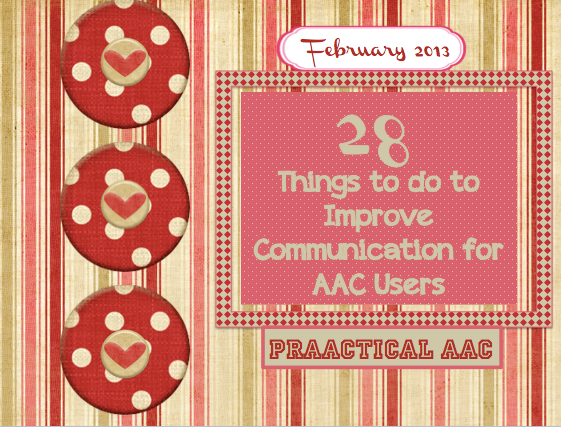
It’s almost February and and we were thinking about ways to encourage communication in a fun and meaningful way for the whole month. The best way we know is to build a visual language environment by providing lots of AAC modeling (Aided Language Input-ALI) and by using lots of visual supports. Here are some ideas to expand opportunities and/or to get started. We would love to know what works, what doesn’t, and any other ways you build visual language into everyday experiences. Use Aided Language Input (ALI) to say ‘I Love You’ . Make it part of a routine Offer learners a book choice board/choice book when deciding what book to read in speech-language therapy/classroom/home Use Aided Language Input (ALI) to tell how you feel when something is hard or difficult for you Use a ‘stop sign’ symbol to indicate an off limit area Use Aided Language Input (ALI) to... [Read More...]









